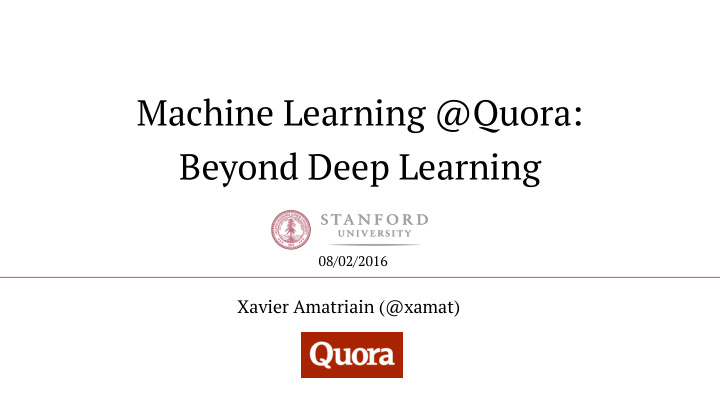



Machine Learning @Quora: Beyond Deep Learning 08/02/2016 Xavier Amatriain (@xamat)
Our Mission “To share and grow the world’s knowledge” • Millions of questions • Millions of answers • Millions of users • Thousands of topics • ...
Lots of high-quality textual information
Text + all those other things
What we care about Relevance Quality Demand
ML Applications click ● Homepage feed ranking ● Email digest ● Answer quality & ranking expand ● Spam & harassment classification upvote share downvote ● Topic/User recommendation ● Trending Topics ● Automated Topic Labelling ● Related & Duplicate Question ● User trustworthiness ● ...
Models ● Deep Neural Networks ● Logistic Regression ● Elastic Nets ● Gradient Boosted Decision Trees ● Random Forests ● LambdaMART ● Matrix Factorization ● LDA ● ... ●
Deep Learning Works
Image Recognition
Speech Recognition
Natural Language Processing
Game Playing
Recommender Systems
But...
Deep Learning is not Magic
Deep Learning is not always that “accurate”
… or that “deep”
Other ML Advances ● Factorization Machines ● Tensor Methods ● Non-parametric Bayesian models ● XGBoost ● Online Learning ● Reinforcement Learning ● Learning to rank ● ...
Other very successful approaches
Is it bad to obsess over Deep Learning?
Some examples
Football or Futbol?
A real-life example Label
A real-life example: improved solution E n s Label e m b l Other feature Accuracy ++ e extraction algorithms
Another real example ● Goal: Supervised Classification ○ 40 features ○ 10k examples ● What did the ML Engineer choose? Multi-layer ANN trained with Tensor ○ Flow ● What was his proposed next step? ○ Try ConvNets ● Where is the problem? ○ Hours to train, already looking into distributing ○ There are much simpler approaches
Why DL is not the only/main solution
Occam’s Razor
Occam’s razor ● Given two models that perform more or less equally, you should always prefer the less complex ● Deep Learning might not be preferred, even if it squeezes a +1% in accuracy
Occam’s razor: reasons to prefer a simpler model
Occam’s razor: reasons to prefer a simpler model ● There are many others ○ System complexity ○ Maintenance ○ Explainability ○ ….
No Free Lunch
No Free Lunch Theorem “ (...) any two optimization algorithms are equivalent when their performance is averaged across all possible problems". “if an algorithm performs well on a certain class of problems then it necessarily pays for that with degraded performance on the set of all remaining problems.”
Feature Engineering
Feature Engineering Need for feature engineering In many cases an understanding of the domain will lead to optimal results.
Feature Engineering Example - Quora Answer Ranking What is a good Quora answer? • truthful • reusable • provides explanation • well formatted • ...
Feature Engineering Example - Quora Answer Ranking How are those dimensions translated into features? • Features that relate to the answer quality itself • Interaction features (upvotes/downvotes, clicks, comments…) • User features (e.g. expertise in topic)
Feature Engineering ● Properties of a well-behaved ML feature: ○ Reusable ○ Transformable ○ Interpretable ○ Reliable
Deep Learning and Feature Engineering
Unsupervised Learning
Unsupervised Learning ● Unsupervised learning is a very important paradigm in theory and in practice ● So far, unsupervised learning has helped deep learning, but the inverse is not true… yet
Supervised/Unsupervised Learning ● Unsupervised learning as dimensionality reduction ● Unsupervised learning as feature engineering ● The “magic” behind combining unsupervised/supervised learning ○ E.g.1 clustering + knn ○ E.g.2 Matrix Factorization ■ MF can be interpreted as ● Unsupervised: ○ Dimensionality Reduction a la PCA ○ Clustering (e.g. NMF) ● Supervised ○ Labeled targets ~ regression
Ensembles
Ensembles Even if all problems end up being suited for Deep Learning, there will always be a place for ensembles. ● Given the output of a Deep Learning prediction, you will be able to combine it with some other model or feature to improve the results.
Ensembles ● Netflix Prize was won by an ensemble ○ Initially Bellkor was using GDBTs ○ BigChaos introduced ANN-based ensemble ● Most practical applications of ML run an ensemble ○ Why wouldn’t you? ○ At least as good as the best of your methods ○ Can add completely different approaches
Ensembles & Feature Engineering ● Ensembles are the way to turn any model into a feature! ● E.g. Don’t know if the way to go is to use Factorization Machines, Tensor Factorization, or RNNs? ○ Treat each model as a “feature” ○ Feed them into an ensemble
Distributing Algorithms
Distributing ML ● Most of what people do in practice can fit into a multi-core machine ○ Smart data sampling ○ Offline schemes ○ Efficient parallel code ● … but not Deep ANNs ● Do you care about costs? How about latencies or system complexity/debuggability?
Distributing ML ● That said… ● Deep Learning has managed to get away by promoting a “new paradigm” of parallel computing: GPU’s
Conclusions
Conclusions ● Deep Learning has had some impressive results lately ● However, Deep Learning is not the only solution It is dangerous to oversell Deep Learning ○ ● Important to take other things into account Other approaches/models ○ ○ Feature Engineering ○ Unsupervised Learning ○ Ensembles Need to distribute, costs, system complexity... ○
Questions?
We’re Hiring… Deep & Shallow Learners
Recommend
More recommend